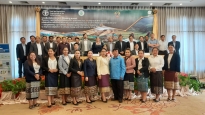The project “Strengthening Agro-climatic Monitoring and Information Systems (SAMIS) to improve adaptation to climate change and food security in LAO PDR” is increasing decision-making and planning capacity for the agricultural sector at national and decentralized levels in Lao PDR. Its objective is to enhance capacities to gather, process, analyse, and share climatic and geospatial information so that these can be applied to planning and decision-making.
As the small scale, the project is building the infrastructure and a comprehensive agro-climatic monitoring and information capacity focused on boosting sustainable production by optimizing farmers and smallholders resilience against climate change. Farmers will therefore be able to take informed judgements about the most appropriate technologies and approaches in face of climate vagaries.
At the national level, detailed future prevision of crop distribution and productivity as well as socio-economical acceptability of farming and cropping systems that will results due to the impact of climate change.
27/11/2023
The Department of Meteorology and Hydrology of the Ministry of Natural Resources and Environment, with support from the Food and...
06/12/2022
The Ministry of Natural Resources and Environment, in collaboration with the Food and Agriculture Organization of the United Nations and...
03/12/2022
Hired by FAO, three independent consultants are conducting an external review of the project final results. The team is composed...
2023
The booklet presents a methodology developed by the activities of the projects “Strengthening Agro-climatic Monitoring and Information Systems (SAMIS) to improve adaptation to climate change and food security in Lao People's Democratic Republic” and “Sustainable Productivity in agriculture in the context of Climate Smart Agriculture and Agro-ecology”. This handbook aims at providing guidance and resource to implement foresight planning at the village level by presenting a full exercise to be conducted at the field level. The exercise is divided in five steps and should allow to visualise possible futures in 2030. The exercise is designed as an added section to the Participatory Forest and Agricultural Land Use Planning, Allocation and Management (pFALUPAM) manual.
This document provides the supplementary materials such as tables, figures, and the pFALUPAM village plan and land use maps for Keosaenkham village that are to be used as example in the real case pFALUPAM exercises.





